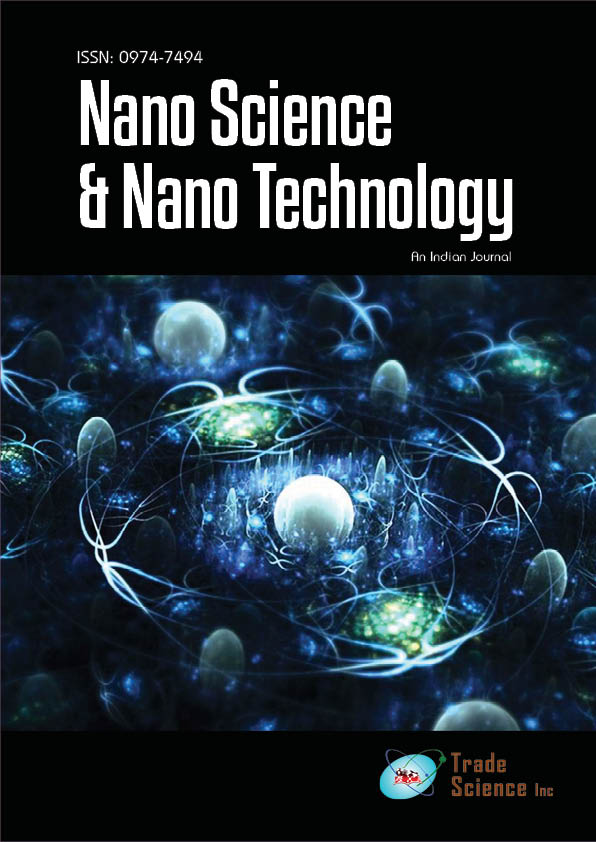Short communication
, Volume: 16( 3) DOI: 2022; 16(3):154Biosensor Applications in Tissue Engineering: Recent Advances
- *Correspondence:
- Kian Moss Editorial office, Nanoscience & nanotechnology: An Indian Journal, UK. ; E-mail: info@tsijournals.com
Citation: Kian Moss. Biosensor Applications in Tissue Engineering: Recent Advances. Nano Tech Nano Sci Ind J. 2022; 16(3):154.
Abstract
Biosensors research is a rapidly expanding topic with tens of thousands of articles published over the years and a market worth billions of dollars. Biosensor devices have been used in a variety of industries, including food and beverage, agriculture, environmental, medical diagnostics, and pharmaceuticals, among others. Despite the development of various biosensors for the detection of proteins, peptides, enzymes, and a variety of other biomolecules for a variety of applications, tissue engineering applications have remained limited. Real-time detection of tiny molecules such as glucose, lactose, and H2O2, as well as serum proteins of large molecular size, such as albumin and alpha-fetoprotein, and inflammatory cytokines, such as IFN-g and TNF-, has piqued interest in recent years. We present an overview of current biosensor improvements for tissue engineering applications in this paper. Biosensors have gotten a lot of attention in medicine and nanotechnology in recent years, and there's a lot of interest in using them in tissue engineering. Researchers in a variety of sectors have produced various biosensors for applications in medicine, biotechnology, and bioterrorism protection, as well as foods, drinks, and environmental and agricultural applications, since the discovery of the first oxygen biosensor by Lel and Clark in 1962Introduction
Biosensors research is a rapidly expanding topic with tens of thousands of articles published over the years and a market worth billions of dollars. Biosensor devices have been used in a variety of industries, including food and beverage, agriculture, environmental, medical diagnostics, and pharmaceuticals, among others. Despite the development of various biosensors for the detection of proteins, peptides, enzymes, and a variety of other biomolecules for a variety of applications, tissue engineering applications have remained limited. Real-time detection of tiny molecules such as glucose, lactose, and H2O2, as well as serum proteins of large molecular size, such as albumin and alpha-fetoprotein, and inflammatory cytokines, such as IFN-g and TNF-, has piqued interest in recent years. We present an overview of current biosensor improvements for tissue engineering applications in this paper. Biosensors have gotten a lot of attention in medicine and nanotechnology in recent years, and there's a lot of interest in using them in tissue engineering. Researchers in a variety of sectors have produced various biosensors for applications in medicine, biotechnology, and bioterrorism protection, as well as foods, drinks, and environmental and agricultural applications, since the discovery of the first oxygen biosensor.
Biosensors have recently shown tremendous promise in tissue engineering and regenerative medicine. Tissue engineering and regenerative medicine are two fast-emerging topics in biomedical engineering that hold tremendous promise for the development of artificial tissue constructions that can restore the functioning of sick or damaged tissues and organs. Biosensors are gradually becoming an important part of tissue engineering systems, especially in microfluidic tissue engineering models, because they can detect specific biological molecules within miniaturized tissue constructs in real-time, at very low concentration levels, using ultrasensitive optical, electrochemical, or acoustic sensing systems. Biosensors have thus far been most often used in blood glucose monitoring. A probe with micro- or nano-dimensions is useful for accurately sensing biological signals in a cellular milieu. Sensors having nanoscale dimensions, such as nanotubes or nanowires, have been created for this purpose, allowing for efficient biosensing and diagnostics. They may be used to assess pH or functionalized with particular capture molecules to detect extremely small amounts of biological and chemical species. Nanocantilevers, for example, have been used to track serum protein marker levels and assess the concentration of certain DNA moieties. Quantum dots are extremely fluorescent semiconductor nanocrystals that may be used to identify particular proteins or DNA.
Biosensors fundamentals
Definition and types
A biosensor is a "self-contained analytical instrument that combines a biological component with a physicochemical component for the detection of a biologically significant analyte." It usually consists of three basic components: (a) a stimulus detector, (b) a transducer to convert the stimulus to an output signal, and (c) a signal processing system to process the output and present it in an appropriate format[1].
Biosensory components or bioreceptors
The biosensing components of biosensors can be divided into two types, namely, catalytic type and affinity type. The catalytic type sensors include enzymes, microbes, organelles, cells, or tissues, while the affinity type includes antibodies, receptors, and nucleic acids. Some of the important ones among these types are discussed below[2].
Enzymes
Enzymes of the oxidase type are commonly utilised as bioreceptor components in biosensors because they can selectively react with certain analytes, consume dissolved O2, and create H2O2, which is a readily detectable molecule. The detection of enzyme activation or inhibition by the analyte, as well as the alteration of enzyme characteristics by the analyte, are further ways of enzyme-based biosensing. Entrapment in gels, covalent bonding, and physical adsorption on the surfaces can all be used to directly immobilise enzyme molecules on transducer surfaces. Enzyme-based biosensing has several benefits, including commercial availability of high-purity enzymes, high specificity of binding capabilities, compatibility with various transduction methods, and the capacity to detect a wide spectrum of analytes[3].
Microbes
Microbes have a lot of benefits as a biological sensing component in biosensor manufacturing. They may be found all around and have a high capacity to adapt to harsh environments and gain the ability to digest novel compounds over time. Enzymes and antibodies are more expensive than microbial cells. They can carry out a variety of complicated processes while remaining stable. Whole cells are available in both viable and nonviable forms. These cells metabolize various organic substances either anaerobically or aerobically, resulting in various end products such as ammonia, carbon dioxide, acids, and so on, which may be monitored using a variety of transducers[4].
Recent biosensor developments
The amazing features of graphene, such as cheap production cost, large specific surface area, strong biocompatibility, high electrical conductivity, and great electrochemical stability, have piqued scientific and technical interest in graphene-based biosensors. Graphene's two-dimensional structure encourages -electron conjugation and makes its surface accessible to various chemical entities. As a result, graphene is becoming a popular material for fabricating different biosensor devices in tissue engineering[5]. Biosensor research is becoming increasingly popular for tissue engineering applications. However, there has been little development. Despite the fact that numerous optical, electrochemical, magnetic, acoustic, thermometric, and piezoelectric sensors have been reported in the literature and, in many cases, are already available on the market, the electrochemical and optical transductions have been the most successful in tissue engineering applications, while thermometric and magnetic transductions have failed to have any practical impact. Biosensor downsizing and integration with microfluidic systems are two obstacles for broad tissue engineering applications.
REFERENCES
- Nurunnabi M, Cho KJ, Choi JS, et.al. Targeted near-IR QDs-loaded micelles for cancer therapy and imaging. 2010; 31(20):5436–44
- Malhotra BD, Singhal R, Chaubey A, Recent trends in biosensors: Current Applied Physics. 2005; 5(2):92–97.
- Hasan A, Memic A, Annabi N, et al. Electrospun scaffolds for tissue engineering of vascular grafts,” Acta Biomaterialia. 2014; 10:11–25.
- Hasan A, Ragaert K, Swieszkowski W, et al. Biomechanical properties of native and tissue engineered heart valve constructs,” Journal of Biomechanics. 2013; 47(9). [Google Scholar]
[Crossref]
- Khatun Z, Nurunnabi M, Cho KJ, et.al. Oral delivery of near-infrared quantum dot loaded micelles for noninvasive biomedical imaging,” ACS Applied Materials and Interfaces. 2012; 4(8): 3880–3887.

